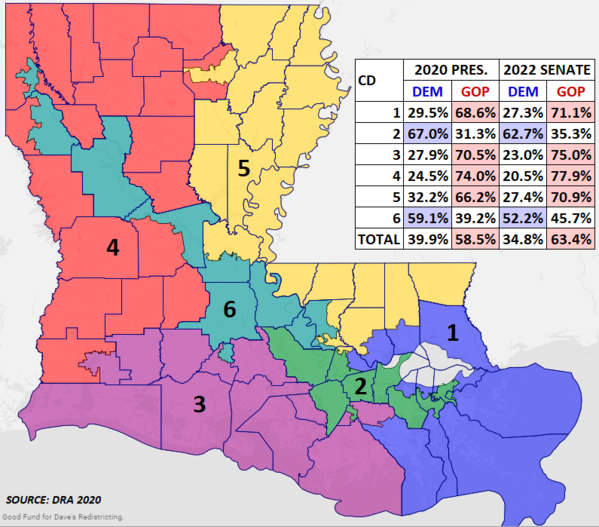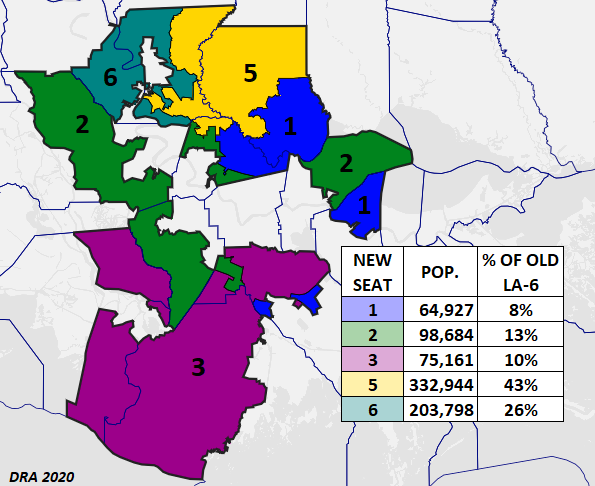The Fields Above the Graves: Louisiana 2024 Redistricting
A Commentary By J. Miles Coleman
In vintage Louisiana fashion, Democrats gain a second Louisiana seat.
KEY POINTS FROM THIS ARTICLE
— Earlier this week, Gov. Jeff Landry (R-LA) signed a new House map that creates a second Black-majority seat in the state.
— The new district, stretching from Baton Rouge to Shreveport, would have favored Joe Biden by 20 points in 2020 and is Safe Democratic.
— Former Rep. Cleo Fields (D) seems to be a frontrunner for the new seat, and, if elected, would return to Congress after a nearly 30 year absence.
— Aside from its partisan implications, the new map could be interpreted as Landry’s attempt at punishing Rep. Garret Graves (R, LA-6).
Table 1: Crystal Ball House ratings change
A blue district along the Red River
After less than a month in office, Louisiana Gov. Jeff Landry, a conservative Republican, somewhat ironically, enacted something that his Democratic predecessor, John Bel Edwards, fought for: He signed into law a congressional map that created a new majority-Black seat. While the motives of Landry, and those of his fellow Republican legislators, were far from altruistic, the map quite plainly provided the new governor an opportunity to settle some scores. But first, some context.
After the 2010 census, Louisiana’s House delegation shrunk from 7 members down to 6. In the first decade of the 21st century, the state saw some truly competitive congressional races: though they were steadily losing ground in statewide elections, Democrats won, or at least made serious attempts, at 6 of the 7 seats during the course of the decade. But since 2012, Louisiana has been home to some of the nation’s most anti-climactic House races: the Crystal Ball has not rated any of its districts as less than Safe for either side since. In fact, because of the state’s now defunct (sort of) jungle primary system (more on that later), intraparty races often became the most hotly contested elections—a2021 special election in the heavily Democratic 2nd District was a recent example.
On the 2012 map, a district that was about 60% Black by composition began in New Orleans and followed Interstate 10 up to Baton Rouge. This was a Safe Democratic seat. Meanwhile, the other 5 districts were Safe Republican—though several had sizable minority populations, their white majorities kept them solidly GOP. Districts 4, 5, and 6, for instance, all were between 25% and 35% Black by composition.
In 2022, the state enacted a minimal change map over the objections of then-Gov. Edwards. Edwards, and his allies on the Democratic side, reasoned that, in a state that is roughly one-third Black by composition, 2 of the state’s 6 districts should be amenable to Black candidates. Though litigation ensued over the enacted map, it was allowed to be used in the 2022 elections—when a predictable 5-1 Republican delegation was elected.
The legality of the 2022 map was essentially in limbo until the U.S. Supreme Court’s Milligan verdict was handed down. In a decision that was considered a win for voting rights advocates and Democrats, the court paved the way for the creation of a second majority-Black. In the wake of Milligan, the 5th Circuit Court of Appeals sided against Louisiana Republicans and gave legislators until January to draw a new map with a second Black-majority seat.
Unlike their counterparts in the Alabama legislature, who seemed to treat the opinions of courts as optional when crafting a do-over map last year, Louisiana Republicans actually passed a map that should elect two Black Democrats to the House. Map 1 considers the new lines.
Map 1: New Louisiana House map
The new Black-majority seat is labeled LA-6. In the early 1990s, Louisiana briefly had maps that featured majority-Black seats that did not touch the New Orleans area. In 1992, a Z-shaped district connected Baton Rouge and Shreveport by hugging the Mississippi and Arkansas borders. In 1994, the seat was redrawn to connect those two cities by following the Red River, for a seat that resembled a backslash. Ahead of the 1996 elections, that seat was ruled unconstitutional, and the New Orleans-centric 2nd District has since been the state’s sole majority-Black district.
In any case, the new 6th District is a throwback to the 1994 “backslash” seat—and it may well have the same occupant. When his old district was dismantled, then-Rep. Cleo Fields, a Black Democrat who was then in his early 30s, opted to run for governor in 1995. Though his foray into statewide politics did not end well—after narrowly beating out then-state Treasurer Mary Landrieu (D) for a runoff berth, he lost a runoff by 27 points to then-state Sen. Mike Foster (R)—Fields is on his third tour of duty in the state legislature and remains an important player in Baton Rouge. Fields announced his candidacy for the House seat on Tuesday. If elected, Fields would have the longest gap in House service (28 years) since now-former Rep. Rick Nolan (D, MN-8) took office in 2013 after a 32-year hiatus.
Aside from Fields, some other Democrats are considering the race. But for our purposes, we’re considering LA-6 a flip, and moving it all the way from Safe Republican to the Safe Democratic category. In 2020, Joe Biden would have carried the new seat by a roughly 60%-40% vote, and in the 2022 jungle primary for Senate (which GOP Sen. John Kennedy won outright) Democratic candidates combined to outvote Republicans there.
Now, did we mention there seemed to be some score-settling going on? With a Black-majority (read: Democratic) seat added to the map, one Republican member had to get “thrown under the bus.” With their positions at the top of the House GOP food chain, Speaker Mike Johnson (R, LA-4) and Majority Leader Steve Scalise (R, LA-1) were not realistically going to be imperiled. In fact, Johnson now has the reddest district on the map—on the outgoing plan, he had the most marginal Trump-won seat, though it was still a seat that gave Biden less than 40% of the vote. In north Louisiana, Rep. Julia Letlow (R, LA-5) is a Scalise ally and in Acadiana, Rep. Clay Higgins’s 3rd District, in the southwestern corner of the state, is hard to dismantle.
That leaves Rep. Garret Graves, of the 6th District, long a Baton Rouge-area seat. Though Graves is a relatively senior member of the House delegation (he’s served longer than all his colleagues except for Scalise), he landed in the hot seat through some recent political decisions that did not work out for him. In office, Graves seemed to hitch his wagon to now-former Speaker Kevin McCarthy (R, CA-20) instead of his home-state colleague Scalise. During the 15-round speakership contest at the start of the new Congress last year that resulted in McCarthy’s short-lived speakership, Graves and Rep. Patrick McHenry (R, NC-10) were critical in wrangling votes for McCarthy. As speaker, McCarthy seemed more reliant on the Graves/McHenry duo than Scalise, who is, on paper, the No. 2 Republican. After McCarthy was ousted, Graves appeared to undermine Scalise’s brief bid for the House’s top job.
Another Graves miscalculation, at least in retrospect, came closer to home. During last year’s gubernatorial race, Graves endorsed former Louisiana Association of Business and Industry leader Stephen Waguespack. Landry, who was the frontrunner for virtually the entire race, won the jungle primary outright while Waguespack took less than 6%. So, without his advocates in DC or Baton Rouge, Gaves clearly lacked protection. We can see this in Map 2, which shows how his old district was split up. About 42% of his seat wound up in Letlow’s 5th District, while smaller pieces of it were incorporated into four other districts.
Map 2: Distribution of the old LA-6
Though Graves insists he’ll run again, he obviously lacks a path back to Washington, and, with Louisiana’s late filing deadline, has ample time to just retire.
Finally, as we mentioned earlier, aside from the new map, one election-related reform that came out of this month’s special session phased out jungle primaries…well, for some offices, at least. Beginning in 2026, Louisiana will use a more “conventional” closed primary system for federal elections, though some statewide elections would still be held under jungle primary rules. The jungle primary system has long been disliked by some partisans on both sides, although more so by conservatives. Landry supported the switch, and, perhaps tellingly, the only legislative Democrat to vote his way on the primary legislation was Fields.
The Louisiana rating change means that the Crystal Ball now rates 213 districts as at least Leans Republican and 204 as at least Leans Democratic, with 18 Toss-ups. There are still some moving pieces in redistricting, most notably in New York, where Democrats hope to get a map that improves their position in a state where they took it on the chin in 2022.
J. Miles Coleman is an elections analyst for Decision Desk HQ and a political cartographer. Follow him on Twitter @jmilescoleman.
See Other Political Commentary by J. Miles Coleman.
See Other Political Commentary.
Views expressed in this column are those of the author, not those of Rasmussen Reports. Comments about this content should be directed to the author or syndicate.
Rasmussen Reports is a media company specializing in the collection, publication and distribution of public opinion information.
We conduct public opinion polls on a variety of topics to inform our audience on events in the news and other topics of interest. To ensure editorial control and independence, we pay for the polls ourselves and generate revenue through the sale of subscriptions, sponsorships, and advertising. Nightly polling on politics, business and lifestyle topics provides the content to update the Rasmussen Reports web site many times each day. If it's in the news, it's in our polls. Additionally, the data drives a daily update newsletter and various media outlets across the country.
Some information, including the Rasmussen Reports daily Presidential Tracking Poll and commentaries are available for free to the general public. Subscriptions are available for $4.95 a month or 34.95 a year that provide subscribers with exclusive access to more than 20 stories per week on upcoming elections, consumer confidence, and issues that affect us all. For those who are really into the numbers, Platinum Members can review demographic crosstabs and a full history of our data.
To learn more about our methodology, click here.



